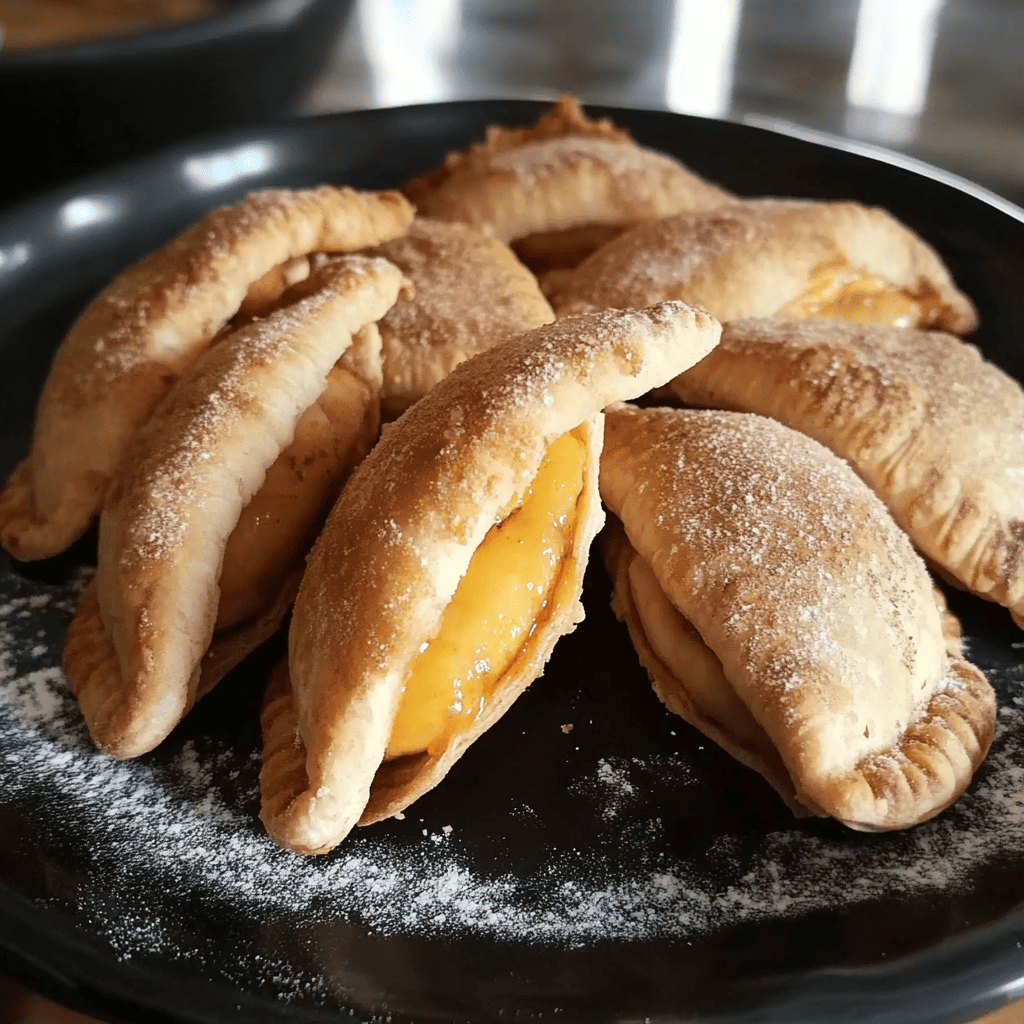Sweet Empanadillas
Introduction to Sweet Empanadillas
Sweet empanadas are a traditional dessert that has been passed down from generation to generation in different parts of the world. Their popularity is due to their versatility , as they can be filled with a wide variety of ingredients such as jams, fruits, dulce de leche, pastry cream, or nuts. Furthermore, their dough can be fried or baked, allowing you to adapt their texture and flavor to your personal preferences.
This delicious snack has deep roots in culinary history and has evolved over time. Although empanadas were originally mostly savory, the introduction of sugar and other sweet ingredients gave rise to the sweet version we know today. Over the centuries, different countries have developed their own recipes and preparation methods, making them a fundamental part of their cuisine.
Today, sweet empanadillas are enjoyed on a variety of occasions, from celebrations and holidays to family snacks. They’re an ideal option for sharing, as they’re simple to prepare and allow for creativity in choosing the filling and decoration.

History of Sweet Empanadillas
Sweet empanadas have a history that dates back centuries. Their origin lies in the empanada tradition, which originated in Arabic cuisine and was introduced to Spain during the Muslim occupation. Over time, this preparation spread throughout Europe and Latin America, adapting to different ingredients and flavors.
In their sweet version, empanadillas began to be prepared with fillings such as dulce de leche, jam, fruit, and chocolate. They became especially popular in countries like Argentina, Mexico, Spain, and the Philippines, where they are part of traditional celebrations and festivities.
Sweet empanadas are a delicious variation on traditional empanadas prepared in different parts of the world, and their history is closely linked to the evolution of savory empanadas , whose origins date back to ancient times. This type of preparation—consisting of a filled, sealed dough—has been a part of many cultures, adapting both in flavors and cooking techniques.
Origin of empanadas: the beginning of the concept
Empanadas have their origins in Arabic cuisine , specifically in recipes such as sambusak , a pastry filled with meat, nuts, or dates. These recipes reached the Iberian Peninsula during the Muslim occupation (8th to 15th centuries). There, the technique of wrapping fillings in dough spread and evolved, giving rise to different regional versions.
In Spain , for example, the traditional Galician empanada emerged , which was later brought by Spanish colonizers to Latin America, where it was adapted to local ingredients and tastes. At the same time, sweeter versions also emerged, using fruits, jams, or sweets typical of each region.
Evolution towards the sweet version
As empanadas spread throughout the world, sweet versions soon appeared , especially as part of homemade baking or religious celebrations and festivals.
During the colonial period in Latin America, the sweet empanada became popular as a practical and economical way to use up cooked fruit, homemade sweets, and even leftover desserts. They became a traditional choice for a snack, breakfast, or as a family dessert.
In Argentina , for example, sweet empanadas are typically filled with quince paste, sweet potato, or milk, and are often sprinkled with sugar or glazed. In Mexico , they are typical at fairs and patron saint festivals, with fillings of cajeta (sweet milk), pineapple, or coconut. In the Philippines , sweet empanadas filled with plantain and brown sugar reflect Hispanic influences adapted to local ingredients.
A recipe with multicultural identity
Thanks to their simplicity and adaptability, sweet empanadillas have transcended borders, becoming a symbol of popular pastries . They are prepared in wood-fired ovens, fried, or baked, depending on local traditions and available resources.
In many countries, they are associated with grandmothers’ cooking, with family recipes passed down from generation to generation, and are especially prepared during celebrations such as Christmas, Easter, carnivals or popular fairs .
The history of sweet empanadas is a blend of cultures, ingenuity, and tradition. Born as a natural evolution of savory empanadas, they have found their place in cuisines around the world thanks to their versatility, flavor, and emotional value.

Ingredients
For the dough:
- 2 cups of wheat flour
- 1/2 cup of sugar
- 1/2 cup butter or margarine (melted)
- 1/2 cup of milk
- 1 teaspoon of vanilla essence
- 1 pinch of salt
- 1 teaspoon baking powder
For the filling (options):
- Caramel sauce
- Fruit jam (strawberry, peach, guava)
- Melted chocolate
- Hazelnut cream
- Cream cheese with sugar
Preparation
- Prepare the dough : In a bowl, mix the flour, sugar, baking powder, and salt. Add the melted butter, milk, and vanilla extract. Knead until smooth and even.
- Rest : Let the dough rest for 30 minutes in the refrigerator to make it easier to handle.
- Form the empanadas : Roll out the dough on a floured surface and cut out circles approximately 10 cm in diameter.
- Filling : Place a teaspoon of your chosen filling in the center of each circle. Fold the dough in half and seal the edges with a fork.
- Cooking :
- Fried option : Fry in hot oil until golden brown. Drain on absorbent paper.
- Baked option : Bake at 180°C for 20-25 minutes until golden brown.
- Finish : Sprinkle with powdered sugar or cinnamon for an extra touch of flavor.
Questions of Interest
- What is the origin of sweet empanadas and in which countries are they most popular?
- What are the differences between fried and baked empanadillas?
- What other fillings can be used to innovate the recipe?
- How can empanadillas be preserved to maintain their freshness?
- What drinks can accompany this dessert to enhance its flavor?
Questions and Other Information in Spanish
- What is the origin of sweet empanadillas?
- Its origins lie in the tradition of empanadas, which originated in Arabic cuisine and were introduced to Spain during the Middle Ages. Over time, the recipe was adapted in different countries, including sweet ingredients.
- What are the most common fillings in sweet empanadas?
- Among the most popular are dulce de leche, chocolate, fruit jam (such as guava, apple, or strawberry), pastry cream, shredded coconut, and cheese with sugar.
- How can sweet empanadas be cooked?
- They can be baked for a lighter, crispier texture or fried for a more golden and crispy finish.
- In which countries are sweet empanadas most popular?
- They are enjoyed in Spain , Mexico , Argentina , Colombia , Venezuela , the Philippines , among others. Each country has its own distinctive version with different fillings and cooking methods.
- Are sweet empanadas healthy?
- It depends on the ingredients and the preparation method. If they’re baked and filled with fruit or less processed ingredients, they can be a healthier option compared to fried and sugary ones.
- Can sweet empanadas be made gluten-free or vegan?
- Yes, there are versions with gluten-free flour and substitutes for animal-based ingredients such as plant-based milk and margarine instead of butter.
Texture and Flavor
- Texture: Crispy or soft on the outside, depending on whether they’re baked or fried . The inside is juicy, creamy, and soft , thanks to the sweet filling (which can be fruit, cream, or dulce de leche).
- Flavor: Varies depending on the filling, but they’re usually sweet, aromatic, and comforting . Some have a touch of cinnamon, vanilla, or citrus zest, giving them a deeper, more homey flavor.
Consumer Context
- Traditional for festivities, fairs, breakfasts, or snacks in many Spanish-speaking countries.
- Very popular during Christmas, Easter, All Saints’ Day or at family events.
- They are also enjoyed as a homemade dessert or to accompany coffee or tea .
Visual Aspect
- Half-moon or round shape, with sealed edges (usually with a fork or crimped).
- They can be sprinkled with icing sugar or cinnamon , or have a honey or syrup bath .
- The browning can vary: brighter if they are fried , or more matte and uniform if they are baked.
Curiosities
- They exist in many regional versions: stuffed with sweet potato, angel hair, dulce de leche, pastry cream, candied fruit or apple .
- In Spain, they are typical in areas such as Andalusia, La Mancha or Galicia , while in Latin America they are found in similar versions (such as sweet empanadas in Argentina or Chile).
- They can be made with homemade dough or with commercial empanada wrappers.
- In some versions, a little anise, rum, or lemon zest is added to the filling to give it a special touch.
Estimated Nutritional Value (per 60–80 g empanada)
(Approximate values depending on the filling and cooking method)
- Calories: 180 – 250 kcal
- Fat: 8 – 14 g (more if fried)
- Carbohydrates: 25 – 35 g
- Sugars: 12 – 22 g
- Protein: 2 – 4 g
- Fiber: 1 – 2 g
- Sodium: low to moderate
Other Interesting Information
- Sweet empanadas can be frozen before cooking , making them ideal for preparing in large quantities.
- They are often served warm, freshly made , but are also delicious cold.
- They can be made into a healthier version by baking them instead of frying them , or using fillings with natural fruit without added sugar.

Conclusion
Sweet empanadas are a delicacy that has transcended borders and generations, becoming a versatile and beloved dessert in many countries. Their ease of preparation and the ability to customize them with different fillings make them a perfect choice for any occasion. Whether fried or baked, these empanadas are an excellent way to enjoy a sweet, homemade treat. Go ahead and make them and surprise your family with their unparalleled flavor!
Sweet empanadas are a dessert with a rich history and a wide variety of variations around the world. Their simple preparation and ability to adapt to different tastes and traditions have made them a classic of homemade baking.
From their origins in Arabic cuisine and their expansion throughout Europe and America, to modern versions with innovative ingredients, sweet empanadas have proven to be a timeless recipe. Today, they are still enjoyed at holidays and family gatherings, keeping the culinary legacy of many cultures alive.
Whether baked or fried, filled with chocolate, fruit, or cream, these little treats are a perfect choice for any occasion. They’re the ideal balance of simplicity, tradition, and flavor , and their preparation remains an act of love and creativity in the kitchen.

